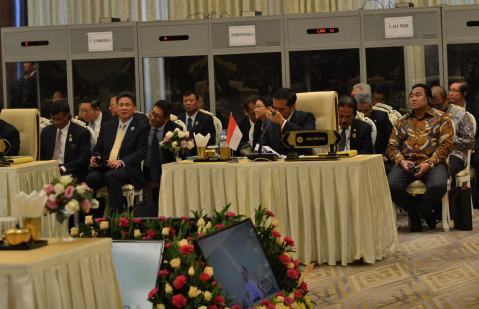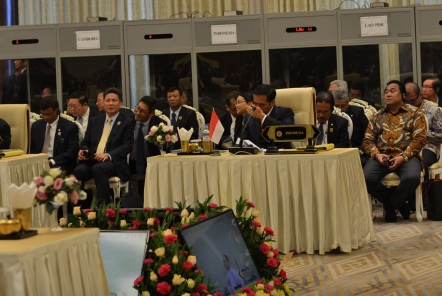In the lead up to today’s ASEAN summit on the Asian migrant crisis, Olivia Cable looks at how inaction is putting democratic credentials to the test.
Southeast Asia is no stranger to ‘democracy’ being used as a convenient and effective means for legitimising a broader set of political, social and economic inequalities. Indonesia and Myanmar are both a case in point.
As the recent Rohingya turmoil highlights, there are many stages of a ‘democratic transition’. Since Indonesia began its transition in the late 1990s, its foreign policy establishment has appropriated democracy into foreign policy discourse. This has helped Indonesia to redefine its national self-image from one of authoritarian rule to democratic inclusion.
Indonesia identifies itself as a regional leader. When chairing ASEAN in 2003, Indonesia’s then President Megawati Sukarnoputri announced at the 36th ASEAN Summit that “ASEAN should be more-proactive, more sensitive to the mainstream values and ideas in international relations, including democracy and greater respect of human rights, and more attentive to its own felt needs.” Her speech marked a re-orientation in regional politics, as the word ‘democratic’ appeared for the first time in an ASEAN document – the 2003 Declaration of Bali Concord II.
Less than two years later, on 19 January 2005 Indonesian Foreign Minister Hassan Wirajuda announced that Indonesia had to “reflect democracy across our region. That is why we are active in promoting democracy in ASEAN.”
Over the past decade, Indonesia’s dealings with Myanmar have been contradictory. On the one hand, Indonesia’s foreign policy establishment have pronounced their trust in Myanmar’s leaders. On the other hand, they have also criticised its leaders for their approach to the Rohingya.
This type of political behaviour is an attempt to create the perception of a social and moral order in Indonesia as well as a tension in its foreign policy between ASEAN solidarity and its desire to uphold human rights. Since language can be interpreted in a myriad of ways, consistency then, is not an essential feature.
The current asylum seeker crisis off Southeast Asian shores has its precedents. In January 2009, 400 Rohingya from Myanmar’s Rakhine State were rescued off the northern coast of Sumatra. While Rohingya asylum seekers have been streaming out of the restive state for decades, their plight gained particular prominence that year when Thailand’s military was accused of towing up to 1,000 asylum seekers back to sea, leaving them without adequate supplies.
After these incidents, Indonesia’s Foreign Minister Wirajuda declared in 2009 that he would consider refugee status for the Rohingya. This comment followed an earlier conundrum: on 23 January 2009, Indonesia refused to grant political asylum to a further 193 Rohingya who arrived in Sabang, off the northern tip of Aceh.
ASEAN seeks to find ‘regional solutions’ to ‘regional problems’. The effects of Myanmar’s egregious mistreatment of its own people has been a frustration for most ASEAN members for decades. As it has often been the case, Myanmar’s political behaviour has attracted unwanted attention to the region. From Southeast Asia, international attention can lead to international intervention.
Sadly, one of Indonesia’s key achievements in dealing with Rohingya in the past has been reaching a regional agreement on semantics. In March 2009, the issue of Rohingya was raised at the ASEAN Summit in Hua Hin. There, ASEAN members sought to define whether the Rohingya were economic migrants, asylum seekers or refugees. Once this had been established, ASEAN could adopt a coordinated policy on their plight. It wasn’t until the issue was transferred to the Bali Process–an annual summit on people smuggling, human trafficking and related transnational crime–that the Rohingya were labeled “illegal migrants from the Indian Ocean.”
This latest wave of boats crossing the sea has also fallen victim to semantics. Indonesia has stated that those on board are only 30 to 40 per cent Rohingya. The rest are Bangladeshi. This time, Indonesia is reported to have labeled the Rohingya as “illegal labourers.”
At a higher level, dealing with the Rohingya situation highlights limitations to the 2008 ASEAN Charter. The Charter states that members must adhere to the “rule of law, good governance, the principles of democracy and constitutional governance.” While this clause suggests members states have committed themselves to new responsibilities and actions, these commitments amount to nothing–the Charter concurrently indicates that ASEAN members have the right to “exist free of all external interference in internal affairs.” No ASEAN country is required to fulfill any human rights standards.
If one is to believe the normative framework of human rights, then absolute commitment to freedom, human rights and regular elections by universal suffrage are essential to any democracy.
Indonesia needs to maneuver between domestic, regional and international expectations. Ignoring the Rohingya issue and dismissing the concerns of democratic powers will place Indonesia’s democratic credentials in question. Attempting to deal with the issue through ASEAN channels will only fail, because as the ASEAN Charter affirms, governments have the power to deal with human rights at their own will. Standing aside will leave the issue to the hands of the international community. The latter will mark ASEAN as a complete failure.
The plight of the Rohingya highlights that protracted disquiet has continued in Myanmar. Since Indonesia identifies itself as a regional leader, its foreign policy establishment must navigate through ASEAN’s doctrine of non-interference, establish and build consensus around a collective position within ASEAN on its approach to dealing with the Rohingya, and manage regional ties with the international community.
Olivia Cable is a Research Assistant with the Coral Bell School of Asia Pacific Affairs at The Australian National University.
 Facebook
Facebook  Twitter
Twitter  Soundcloud
Soundcloud  Youtube
Youtube  Rss
Rss 
